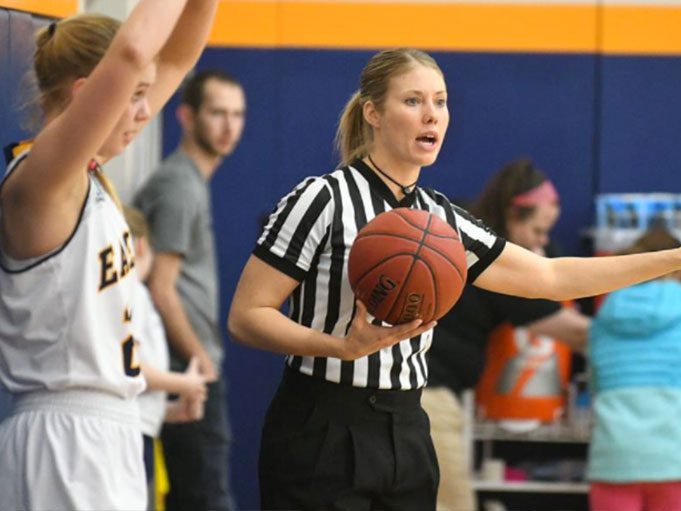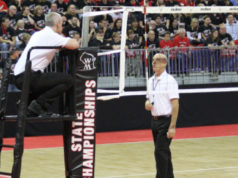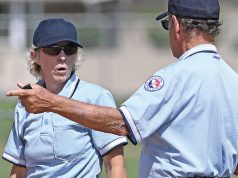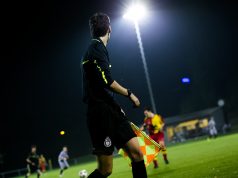A game is a kind of dance, with its own unique rhythm. Not completely, but they have similar elements. One team is on offense and the other has the role of defender. They switch places. One leads, and the other reacts. The movement is up and down, in and out, around and around. Officials can either help or hinder that movement.
Watch major leaguers throw the ball around the horn. No player holds it for more than a moment. Would an umpire interfere in that routine? Only if the ball needed to be inspected for moisture or some other reason, and even then, only for a moment.
Watch college and pro football officials pass the ball to one another after a play to set it for the next snap. They never drop the ball. They always toss it underhand, accurately. If the distance is too long, they estimate it immediately and move toward one another to shorten the distance.
Those are small things, but superior officiating means being aware of the rhythms of the game and contributing to the flow, not disrupting it needlessly.
Rhythm in a game is not always evident at lower levels. In youth or freshman games you’ll see umpires come together between innings and chat, oblivious to teams moving on or off the diamond. In basketball games, inbounding the ball becomes a charade in slow motion, and administering a free throw is agonizingly deliberate.
Good teams move with dispatch. Sloppy and inept teams delay and mill about. Watch baseball and softball teams at the end of an inning. You can almost tell the score by the way they move. Skill, talent and rhythm have a way of meshing.
What can officials do to facilitate that harmony? The one fundamental ingredient in all sports is keeping the ball in play. Baseball and softball umpires can pop a ball into the catcher’s mitt a split second after a foul ball hits the screen. Football officials can pluck the ball from a runner and whip it back to the inbounds spot as soon as a down ends, and incomplete passes can be swiftly and smoothly retrieved and relayed back to the previous spot. Basketball and soccer officials can get the ball back in action quickly after it goes out of bounds.
Keep in mind that fouls and penalties in soccer, football and basketball can also automatically disrupt any established flow of action. Changing pitchers during or between batters in baseball and softball has the same effect. You don’t have to rush any of those administrations, but you also don’t have to prolong the outcome with your own overly deliberate processes.
Move with dispatch when you can, and encourage others to restart the steady tempo as well. If you are a laggard, you will be an irritant. Sluggish officials contribute to a feeling of annoyance among participants. You can “advance the dance” with a conscious effort.
Some other ways to avoid unnecessary disruptions include moving bats back between hitters, getting the tee off the field right after the ball becomes dead and easing cheerleaders back from the sidelines during down-time intervals.
Sometimes the action stalls in ways that officials cannot control. When that happens, officials must use discretion in “administering” to the interruption and restarting the fluidity. If a player gets hurt, a piece of equipment dislodges, or a dog runs onto the playing field, a delay is inevitable. But there are some things you can do. For example, officials should be aware that an injury can cause trauma among teammates. Helping to move players away from the injured player and offering a word of comfort can be calming techniques.
Another way that officials can promote the rhythm of a contest is by assisting one another in calling the game. Baseball and softball umpires should be conscientious about helping partners by watching runners touch bases and backing each other up when a controversial call takes place. Football and basketball officials have zones to cover, but they can also help each other by looking beyond their own assigned territory when no action is taking place in their immediate vicinity.
A final hint: Speaking to players should be done in an unobtrusive way. It goes without saying that any words aimed at participants should have a purpose. If a player is close to fouling or if a pitcher is showing improper disgust with the plate umpire’s calls, get word to the catcher or speak to the player in question directly when the ball is not in play. An official has no right to disrupt the concentration of a player who is intent on playing the game with a heightened focus.
What's Your Call? Leave a Comment:
Note: This article is archival in nature. Rules, interpretations, mechanics, philosophies and other information may or may not be correct for the current year.
This article is the copyright of ©Referee Enterprises, Inc., and may not be republished in whole or in part online, in print or in any capacity without expressed written permission from Referee. The article is made available for educational use by individuals.


















